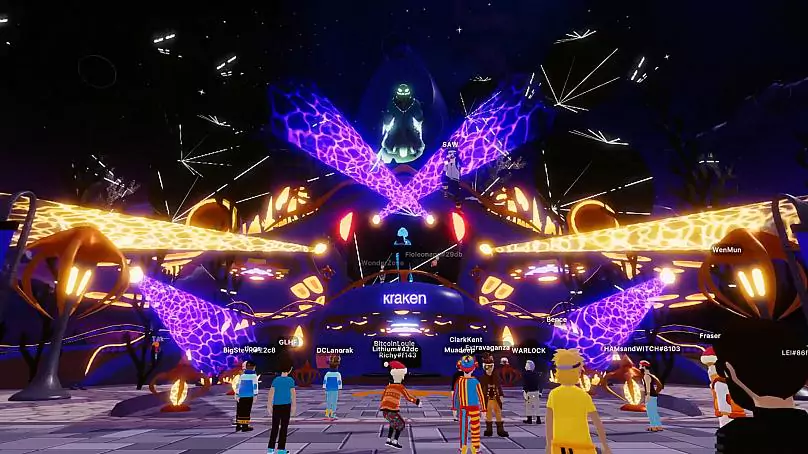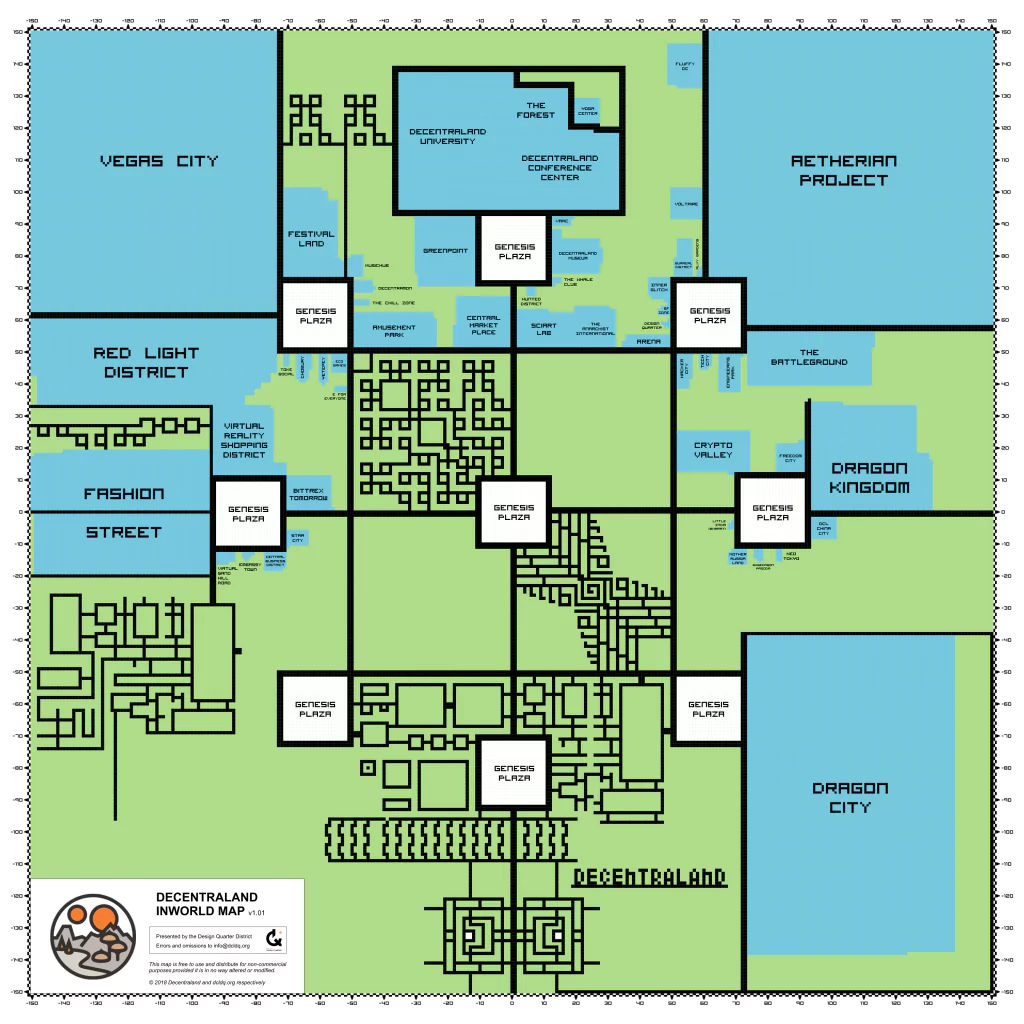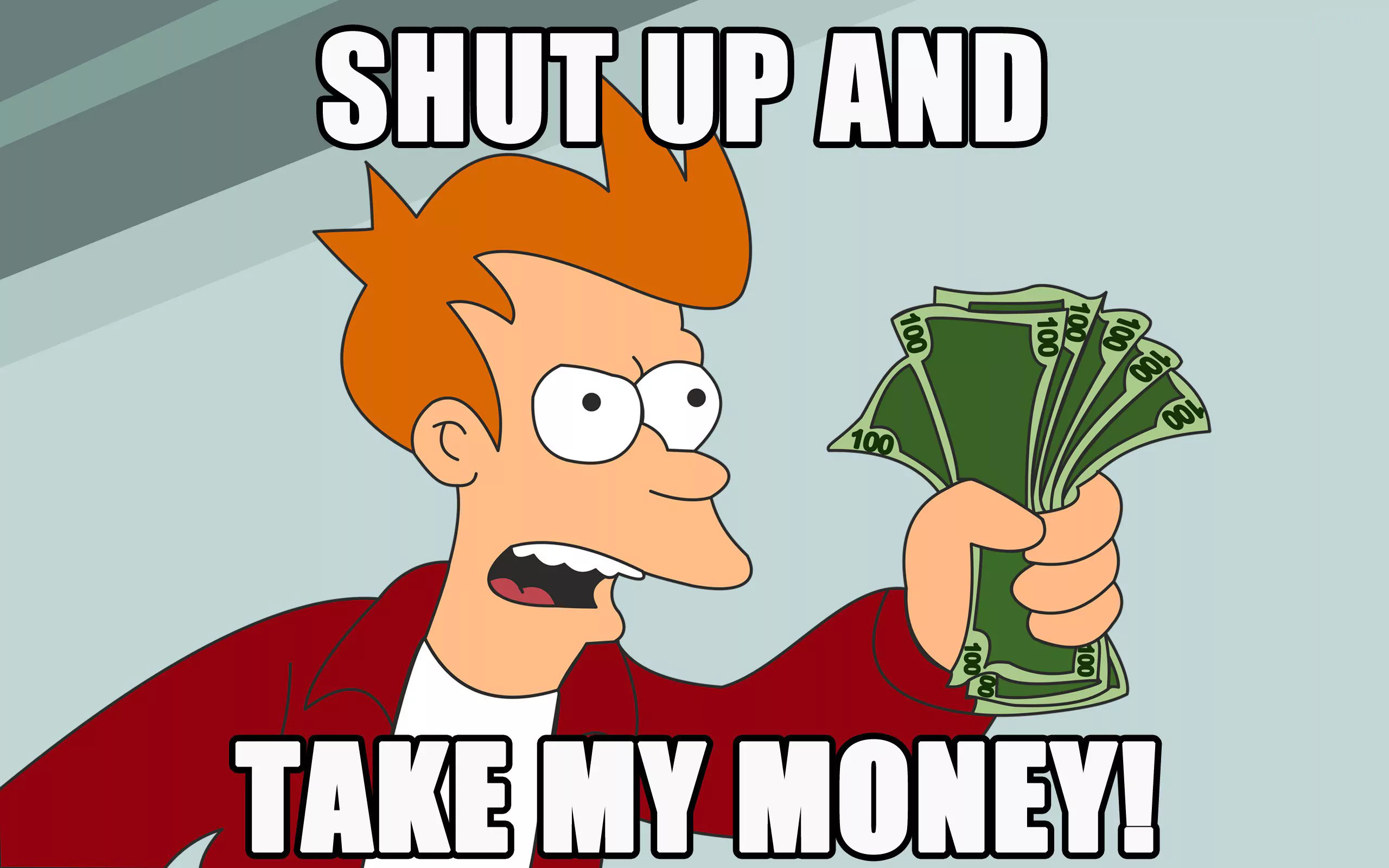Decentraland is perhaps the most popular decentralized virtual reality platform today. In fact, it is a full-fledged metaverse where people can buy and sell plots of land, build various structures on them, attend art projects, events, play games, and monetize their time in the world. This description doesn’t sound unusual, so why is Decentraland now being talked about by all the leading media on the planet?
 Nowadays, Decentraland looks like a 3D video game straight out of the 90s, but it all started with an even more dull two-dimensional pixel map. The history of the project began in 2015, when the Decentraland Foundation released its first MVP — a pixel grid where users could buy territories. Already in 2017, the project turned into a full-fledged 3D world based on the blockchain, and the number of opportunities to occupy oneself in the Decentraland space began to grow rapidly. The general public saw a full-fledged launch in 2020, when the lands of the meta-universe finally turned into NFTs.
In the Decentraland world, you can operate with two tokens: LAND and MANA. LAND is a token that can be used to purchase NFTs of the world’s land plots, which consists of a little over 90,000 pieces. You can buy parts of the game world on various marketplaces (for example, OpenSea) and name your real estate. It all sounds like a child’s toy, but it’s a toy with very childish prices: the cost of land in the metaverse starts at $ 10,000 and can reach several million. MANA, in turn, is the world’s internal currency. Users can use these tokens to participate in auctions for LAND, vote on the development of the platform, level up their game character, and interact with others in every possible way.
Despite the obviousness of this fact, one of the main features of the meta-universe is its decentralization. All decisions regarding changes on the platform are made by a joint vote of the community (a kind of referendum) and external forces, including the project creators, cannot influence this (at least they try to assure us of this).
In short, the platform’s territory is divided into thematic areas where users can get a variety of experiences: from walking through the stores of popular brands that exist in reality (read more in our article on Metaverse Fashion Week) to listening to lectures in the classrooms of DCL University. For the most insatiable, we even built a Red Light District.
How does the Decentralend world work?
First of all, layer levels are important. There are three of them:
Nowadays, Decentraland looks like a 3D video game straight out of the 90s, but it all started with an even more dull two-dimensional pixel map. The history of the project began in 2015, when the Decentraland Foundation released its first MVP — a pixel grid where users could buy territories. Already in 2017, the project turned into a full-fledged 3D world based on the blockchain, and the number of opportunities to occupy oneself in the Decentraland space began to grow rapidly. The general public saw a full-fledged launch in 2020, when the lands of the meta-universe finally turned into NFTs.
In the Decentraland world, you can operate with two tokens: LAND and MANA. LAND is a token that can be used to purchase NFTs of the world’s land plots, which consists of a little over 90,000 pieces. You can buy parts of the game world on various marketplaces (for example, OpenSea) and name your real estate. It all sounds like a child’s toy, but it’s a toy with very childish prices: the cost of land in the metaverse starts at $ 10,000 and can reach several million. MANA, in turn, is the world’s internal currency. Users can use these tokens to participate in auctions for LAND, vote on the development of the platform, level up their game character, and interact with others in every possible way.
Despite the obviousness of this fact, one of the main features of the meta-universe is its decentralization. All decisions regarding changes on the platform are made by a joint vote of the community (a kind of referendum) and external forces, including the project creators, cannot influence this (at least they try to assure us of this).
In short, the platform’s territory is divided into thematic areas where users can get a variety of experiences: from walking through the stores of popular brands that exist in reality (read more in our article on Metaverse Fashion Week) to listening to lectures in the classrooms of DCL University. For the most insatiable, we even built a Red Light District.
How does the Decentralend world work?
First of all, layer levels are important. There are three of them:
 Each district holds votes that establish internal rules and determine the direction of development. Some restrictions may apply to construction on their own territory.
The owners of the plots choose the architectural style of the district and manage the profits. The district’s budget is distributed through DAOs. The founders proposed a collective management model at the time of launch, but the project was fully under the control of the community only in 2020.
Not only ordinary people, but also the world’s largest brands are investing in Decentraland: Coca Cola Company, Atari, Republic Realm, Samsung, and many others have already bought land on the platform. Playboy has built a virtual art gallery there (Hefner, come back, Playboy is not the same anymore!), and Sotheby’s has built a copy of its headquarters, where they successfully sell lots. But the main event happened in November 2021, when the government of Barbados bought a plot of land for the needs of the virtual embassy. Thanks to this deal, Barbados became the first country with an embassy in the metaverse.
Decentraland is not an ideal metaverse — it has a lot of bugs, it takes a long time to load, and after big events, the world looks like a post-apocalyptic one — finding active players in it is quite a task. Like Trezor, the platform has recently suffered from a leak of email addresses of some of its users.
Nevertheless, brands are investing millions of dollars in the game almost without hesitation and experimenting with the existing functionality. For a mass audience, the game lacks at least high-quality graphics, which, however, can be explained — each graphic element (texture) is part of the overall blockchain, and therefore visual development is directly related to the speed of the crypto chain.
Each district holds votes that establish internal rules and determine the direction of development. Some restrictions may apply to construction on their own territory.
The owners of the plots choose the architectural style of the district and manage the profits. The district’s budget is distributed through DAOs. The founders proposed a collective management model at the time of launch, but the project was fully under the control of the community only in 2020.
Not only ordinary people, but also the world’s largest brands are investing in Decentraland: Coca Cola Company, Atari, Republic Realm, Samsung, and many others have already bought land on the platform. Playboy has built a virtual art gallery there (Hefner, come back, Playboy is not the same anymore!), and Sotheby’s has built a copy of its headquarters, where they successfully sell lots. But the main event happened in November 2021, when the government of Barbados bought a plot of land for the needs of the virtual embassy. Thanks to this deal, Barbados became the first country with an embassy in the metaverse.
Decentraland is not an ideal metaverse — it has a lot of bugs, it takes a long time to load, and after big events, the world looks like a post-apocalyptic one — finding active players in it is quite a task. Like Trezor, the platform has recently suffered from a leak of email addresses of some of its users.
Nevertheless, brands are investing millions of dollars in the game almost without hesitation and experimenting with the existing functionality. For a mass audience, the game lacks at least high-quality graphics, which, however, can be explained — each graphic element (texture) is part of the overall blockchain, and therefore visual development is directly related to the speed of the crypto chain.
 Developers and external analysts assure that in the next few years, the problem of graphics will be solved, and the mass audience will come to the project with it. By this time, brands that have just started their experiments in the meta-space will have finally settled in and will be able to offer the audience endless fan and exciting experiences. And while we are waiting, we hear about the launch of new meta-universes in the news. Therefore, the value of the project is not only and not so much in its uniqueness as in the fact that Decentraland has pioneered a crypto n icheestimated by experts to be worth $ 13 trillion by the end of this decade.
Developers and external analysts assure that in the next few years, the problem of graphics will be solved, and the mass audience will come to the project with it. By this time, brands that have just started their experiments in the meta-space will have finally settled in and will be able to offer the audience endless fan and exciting experiences. And while we are waiting, we hear about the launch of new meta-universes in the news. Therefore, the value of the project is not only and not so much in its uniqueness as in the fact that Decentraland has pioneered a crypto n icheestimated by experts to be worth $ 13 trillion by the end of this decade.
 Nowadays, Decentraland looks like a 3D video game straight out of the 90s, but it all started with an even more dull two-dimensional pixel map. The history of the project began in 2015, when the Decentraland Foundation released its first MVP — a pixel grid where users could buy territories. Already in 2017, the project turned into a full-fledged 3D world based on the blockchain, and the number of opportunities to occupy oneself in the Decentraland space began to grow rapidly. The general public saw a full-fledged launch in 2020, when the lands of the meta-universe finally turned into NFTs.
In the Decentraland world, you can operate with two tokens: LAND and MANA. LAND is a token that can be used to purchase NFTs of the world’s land plots, which consists of a little over 90,000 pieces. You can buy parts of the game world on various marketplaces (for example, OpenSea) and name your real estate. It all sounds like a child’s toy, but it’s a toy with very childish prices: the cost of land in the metaverse starts at $ 10,000 and can reach several million. MANA, in turn, is the world’s internal currency. Users can use these tokens to participate in auctions for LAND, vote on the development of the platform, level up their game character, and interact with others in every possible way.
Despite the obviousness of this fact, one of the main features of the meta-universe is its decentralization. All decisions regarding changes on the platform are made by a joint vote of the community (a kind of referendum) and external forces, including the project creators, cannot influence this (at least they try to assure us of this).
In short, the platform’s territory is divided into thematic areas where users can get a variety of experiences: from walking through the stores of popular brands that exist in reality (read more in our article on Metaverse Fashion Week) to listening to lectures in the classrooms of DCL University. For the most insatiable, we even built a Red Light District.
How does the Decentralend world work?
First of all, layer levels are important. There are three of them:
Nowadays, Decentraland looks like a 3D video game straight out of the 90s, but it all started with an even more dull two-dimensional pixel map. The history of the project began in 2015, when the Decentraland Foundation released its first MVP — a pixel grid where users could buy territories. Already in 2017, the project turned into a full-fledged 3D world based on the blockchain, and the number of opportunities to occupy oneself in the Decentraland space began to grow rapidly. The general public saw a full-fledged launch in 2020, when the lands of the meta-universe finally turned into NFTs.
In the Decentraland world, you can operate with two tokens: LAND and MANA. LAND is a token that can be used to purchase NFTs of the world’s land plots, which consists of a little over 90,000 pieces. You can buy parts of the game world on various marketplaces (for example, OpenSea) and name your real estate. It all sounds like a child’s toy, but it’s a toy with very childish prices: the cost of land in the metaverse starts at $ 10,000 and can reach several million. MANA, in turn, is the world’s internal currency. Users can use these tokens to participate in auctions for LAND, vote on the development of the platform, level up their game character, and interact with others in every possible way.
Despite the obviousness of this fact, one of the main features of the meta-universe is its decentralization. All decisions regarding changes on the platform are made by a joint vote of the community (a kind of referendum) and external forces, including the project creators, cannot influence this (at least they try to assure us of this).
In short, the platform’s territory is divided into thematic areas where users can get a variety of experiences: from walking through the stores of popular brands that exist in reality (read more in our article on Metaverse Fashion Week) to listening to lectures in the classrooms of DCL University. For the most insatiable, we even built a Red Light District.
How does the Decentralend world work?
First of all, layer levels are important. There are three of them:
- Theconsensus layer tracks the rights to virtual property. Decentraland uses Ethereum smart contracts to issue irreplaceable tokens, including LAND. This layer contains information about the owners of virtual plots and objects. The coordinates of the territories are stored in the blockchain.
- Thecontent layer is a decentralized data storage system. Users host files that are necessary to display the game space and its objects (and not somewhere in one place with all possible risks). This layer contains static elements, textures, audio recordings, and element descriptions. That is, the information necessary for the scenarios to work.
- TheReal-time layer allows users to interact with the virtual world and with each other. The tool provides real-time data download from the storage and connection of avatars.
- Aetheria. It is the largest district of the metaverse with more than 8000 plots. The district includes real estate and cyberpunk objects.
- Vegas City. The district consists of more than 6000 plots. The district’s activities are focused on gambling. Casinos, nightclubs, and shops are widespread here.
- Dragon City. The district harmoniously combines Western and Eastern cultures. It has real estate in various architectural styles.
- Fashion Street. The district is filled with shops of well-known companies. Thanks to virtual reality technologies, visitors can look at the things they like and buy them.
 Each district holds votes that establish internal rules and determine the direction of development. Some restrictions may apply to construction on their own territory.
The owners of the plots choose the architectural style of the district and manage the profits. The district’s budget is distributed through DAOs. The founders proposed a collective management model at the time of launch, but the project was fully under the control of the community only in 2020.
Not only ordinary people, but also the world’s largest brands are investing in Decentraland: Coca Cola Company, Atari, Republic Realm, Samsung, and many others have already bought land on the platform. Playboy has built a virtual art gallery there (Hefner, come back, Playboy is not the same anymore!), and Sotheby’s has built a copy of its headquarters, where they successfully sell lots. But the main event happened in November 2021, when the government of Barbados bought a plot of land for the needs of the virtual embassy. Thanks to this deal, Barbados became the first country with an embassy in the metaverse.
Decentraland is not an ideal metaverse — it has a lot of bugs, it takes a long time to load, and after big events, the world looks like a post-apocalyptic one — finding active players in it is quite a task. Like Trezor, the platform has recently suffered from a leak of email addresses of some of its users.
Nevertheless, brands are investing millions of dollars in the game almost without hesitation and experimenting with the existing functionality. For a mass audience, the game lacks at least high-quality graphics, which, however, can be explained — each graphic element (texture) is part of the overall blockchain, and therefore visual development is directly related to the speed of the crypto chain.
Each district holds votes that establish internal rules and determine the direction of development. Some restrictions may apply to construction on their own territory.
The owners of the plots choose the architectural style of the district and manage the profits. The district’s budget is distributed through DAOs. The founders proposed a collective management model at the time of launch, but the project was fully under the control of the community only in 2020.
Not only ordinary people, but also the world’s largest brands are investing in Decentraland: Coca Cola Company, Atari, Republic Realm, Samsung, and many others have already bought land on the platform. Playboy has built a virtual art gallery there (Hefner, come back, Playboy is not the same anymore!), and Sotheby’s has built a copy of its headquarters, where they successfully sell lots. But the main event happened in November 2021, when the government of Barbados bought a plot of land for the needs of the virtual embassy. Thanks to this deal, Barbados became the first country with an embassy in the metaverse.
Decentraland is not an ideal metaverse — it has a lot of bugs, it takes a long time to load, and after big events, the world looks like a post-apocalyptic one — finding active players in it is quite a task. Like Trezor, the platform has recently suffered from a leak of email addresses of some of its users.
Nevertheless, brands are investing millions of dollars in the game almost without hesitation and experimenting with the existing functionality. For a mass audience, the game lacks at least high-quality graphics, which, however, can be explained — each graphic element (texture) is part of the overall blockchain, and therefore visual development is directly related to the speed of the crypto chain.
 Developers and external analysts assure that in the next few years, the problem of graphics will be solved, and the mass audience will come to the project with it. By this time, brands that have just started their experiments in the meta-space will have finally settled in and will be able to offer the audience endless fan and exciting experiences. And while we are waiting, we hear about the launch of new meta-universes in the news. Therefore, the value of the project is not only and not so much in its uniqueness as in the fact that Decentraland has pioneered a crypto n icheestimated by experts to be worth $ 13 trillion by the end of this decade.
Developers and external analysts assure that in the next few years, the problem of graphics will be solved, and the mass audience will come to the project with it. By this time, brands that have just started their experiments in the meta-space will have finally settled in and will be able to offer the audience endless fan and exciting experiences. And while we are waiting, we hear about the launch of new meta-universes in the news. Therefore, the value of the project is not only and not so much in its uniqueness as in the fact that Decentraland has pioneered a crypto n icheestimated by experts to be worth $ 13 trillion by the end of this decade.


